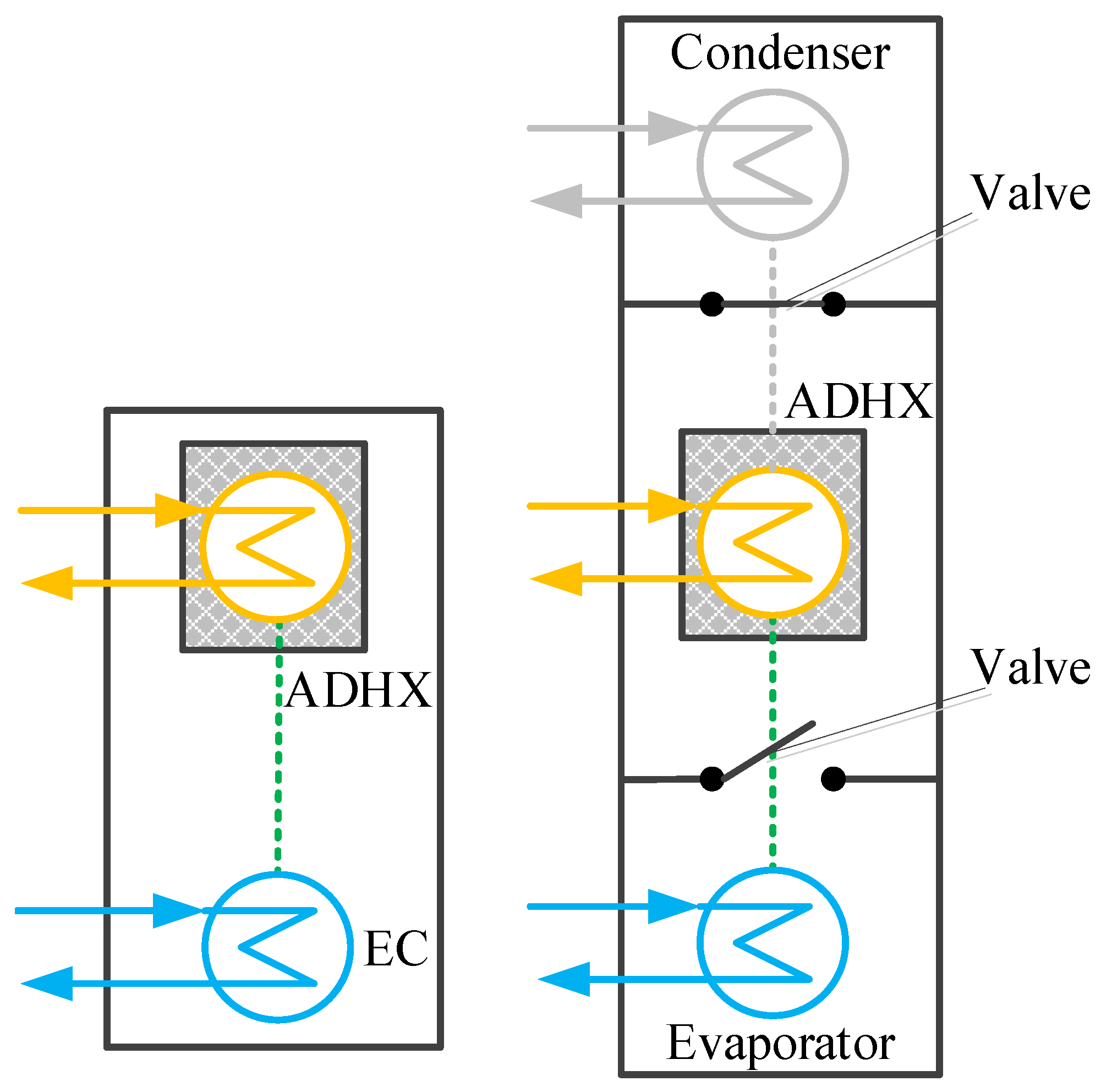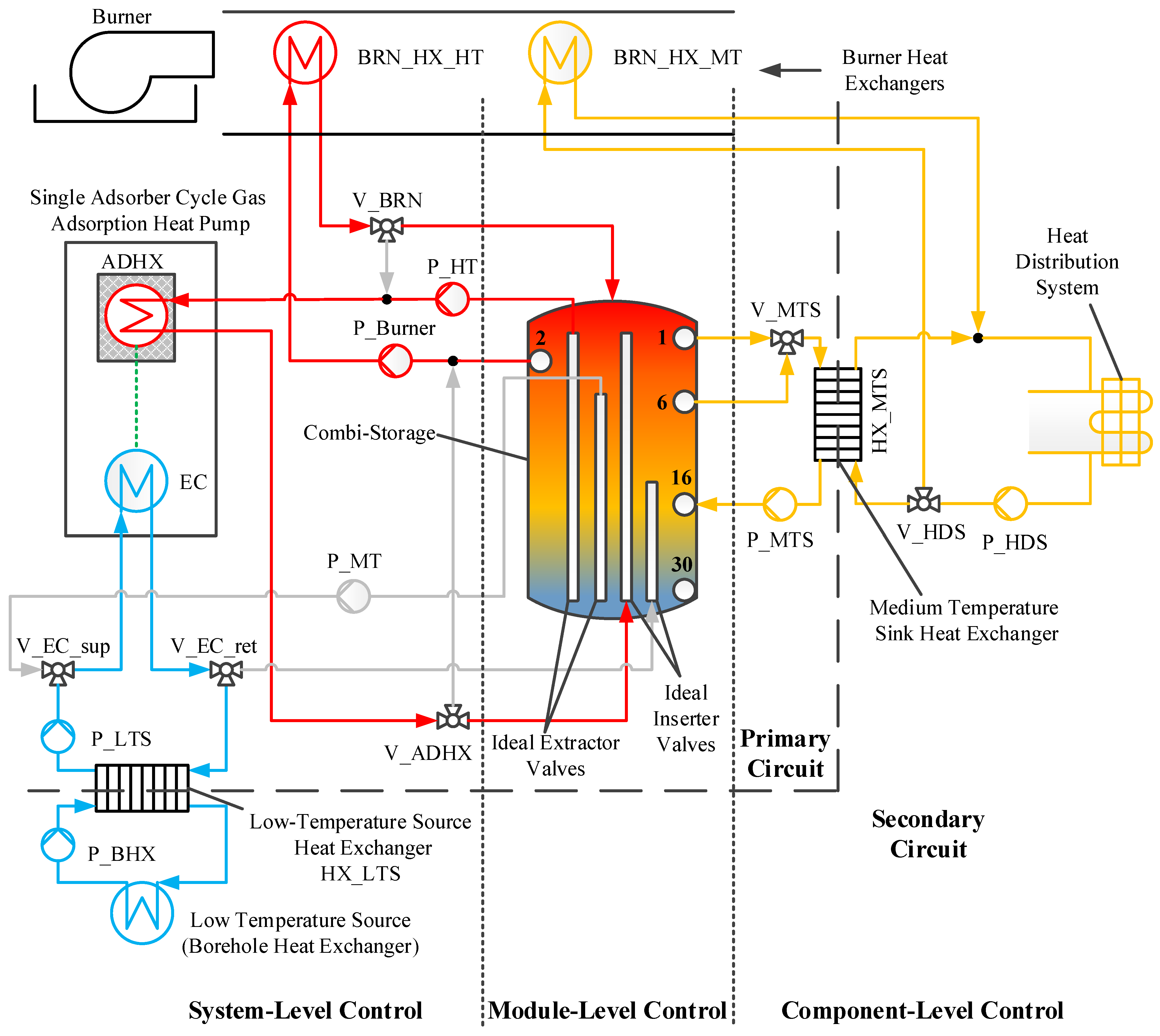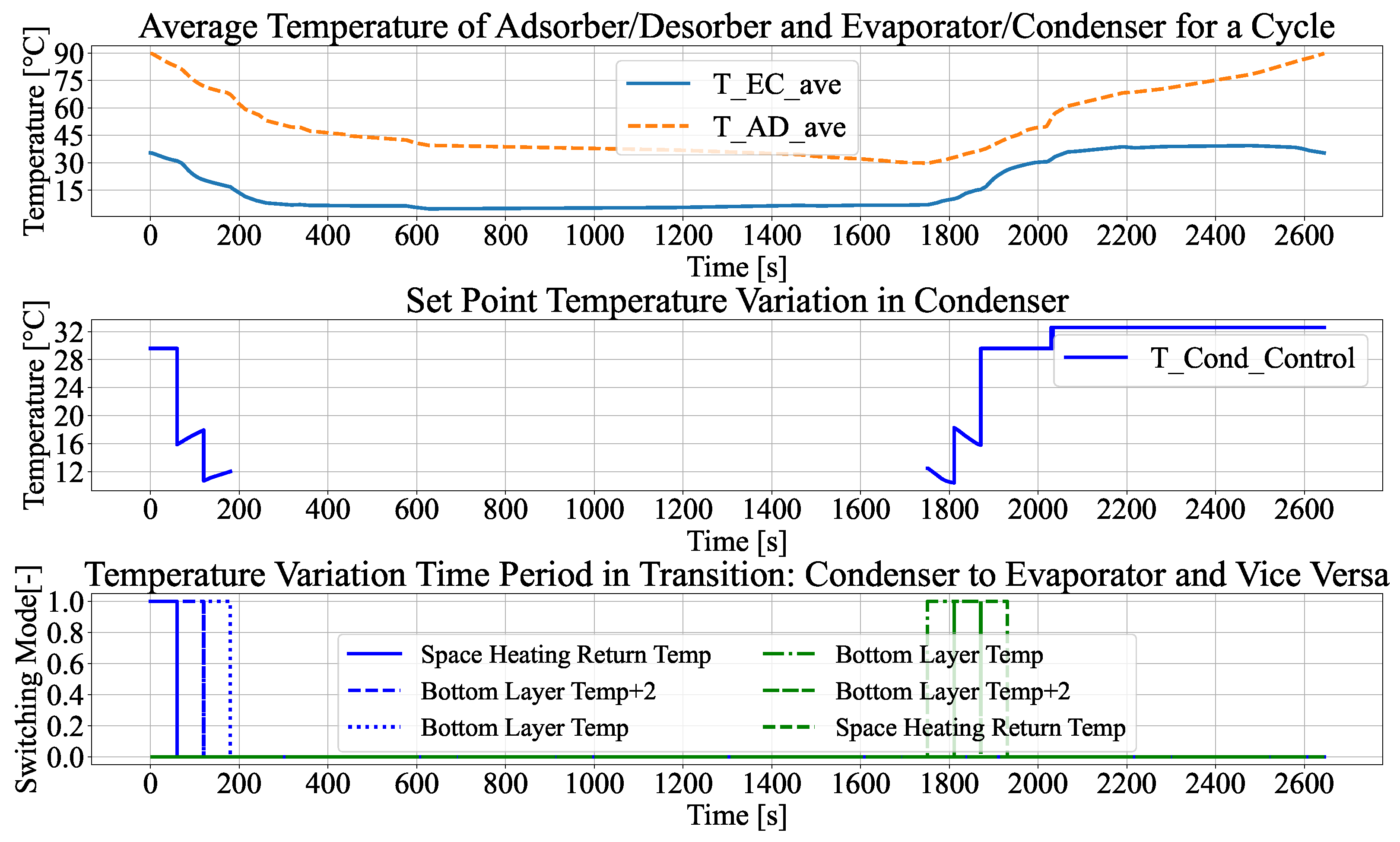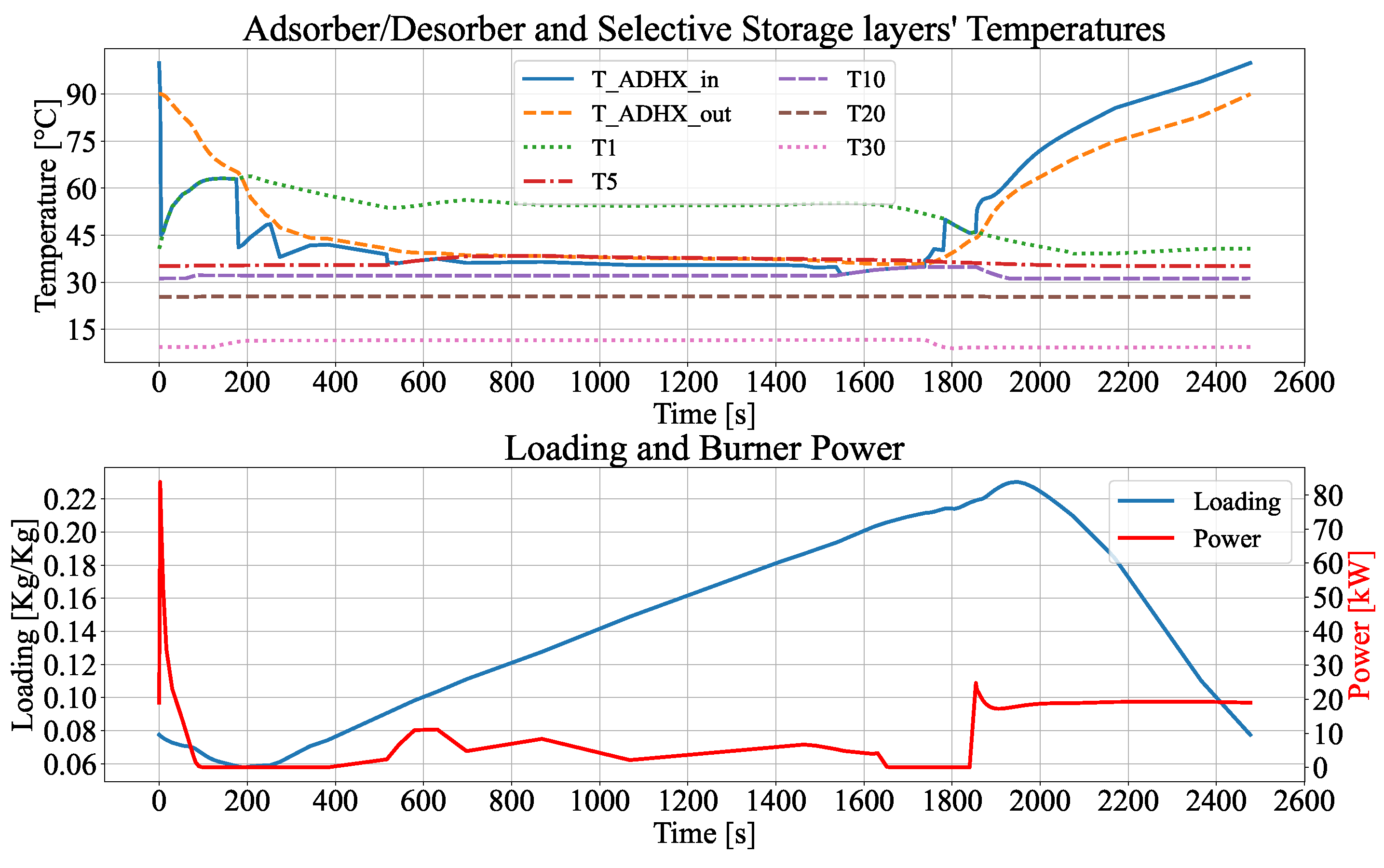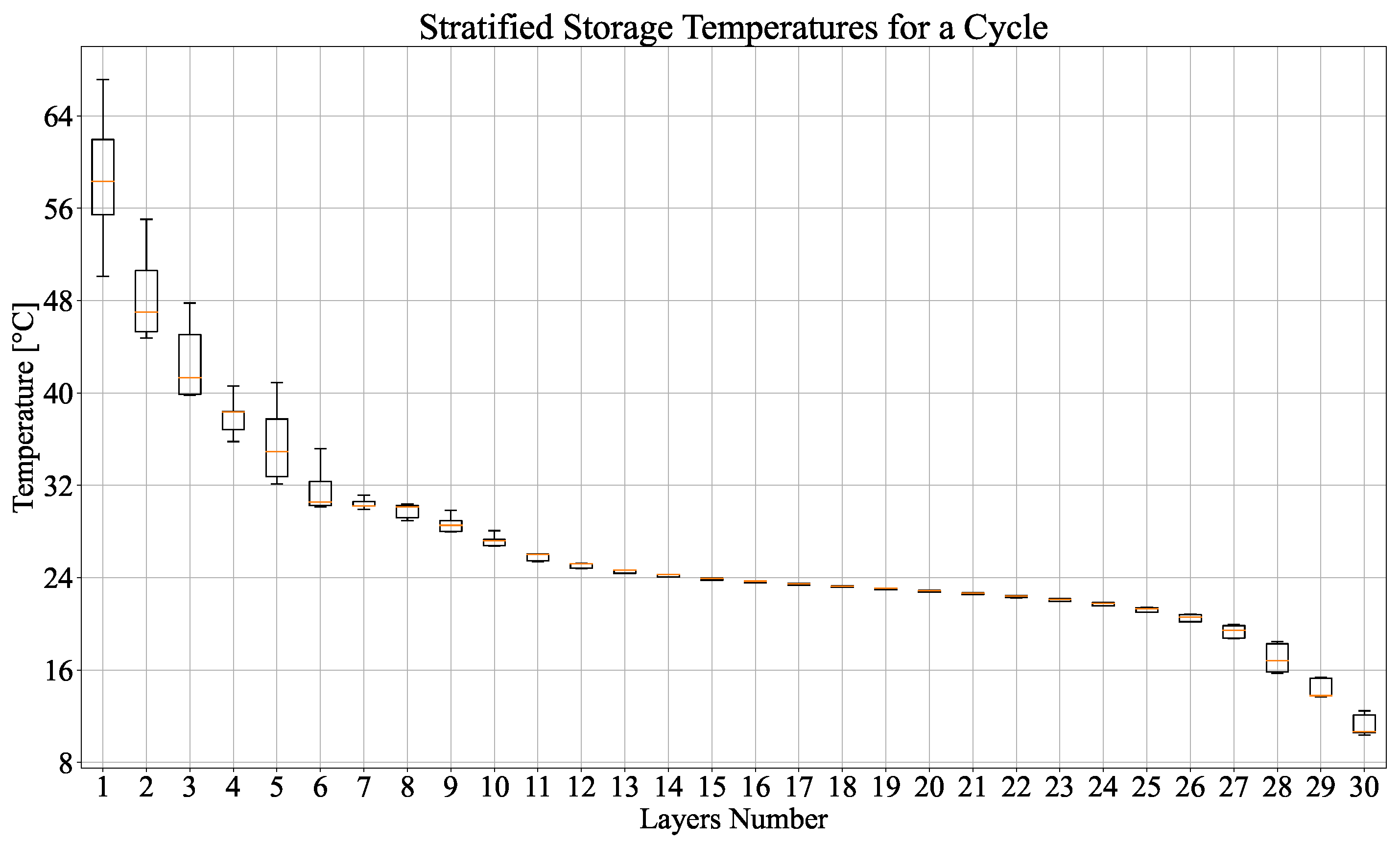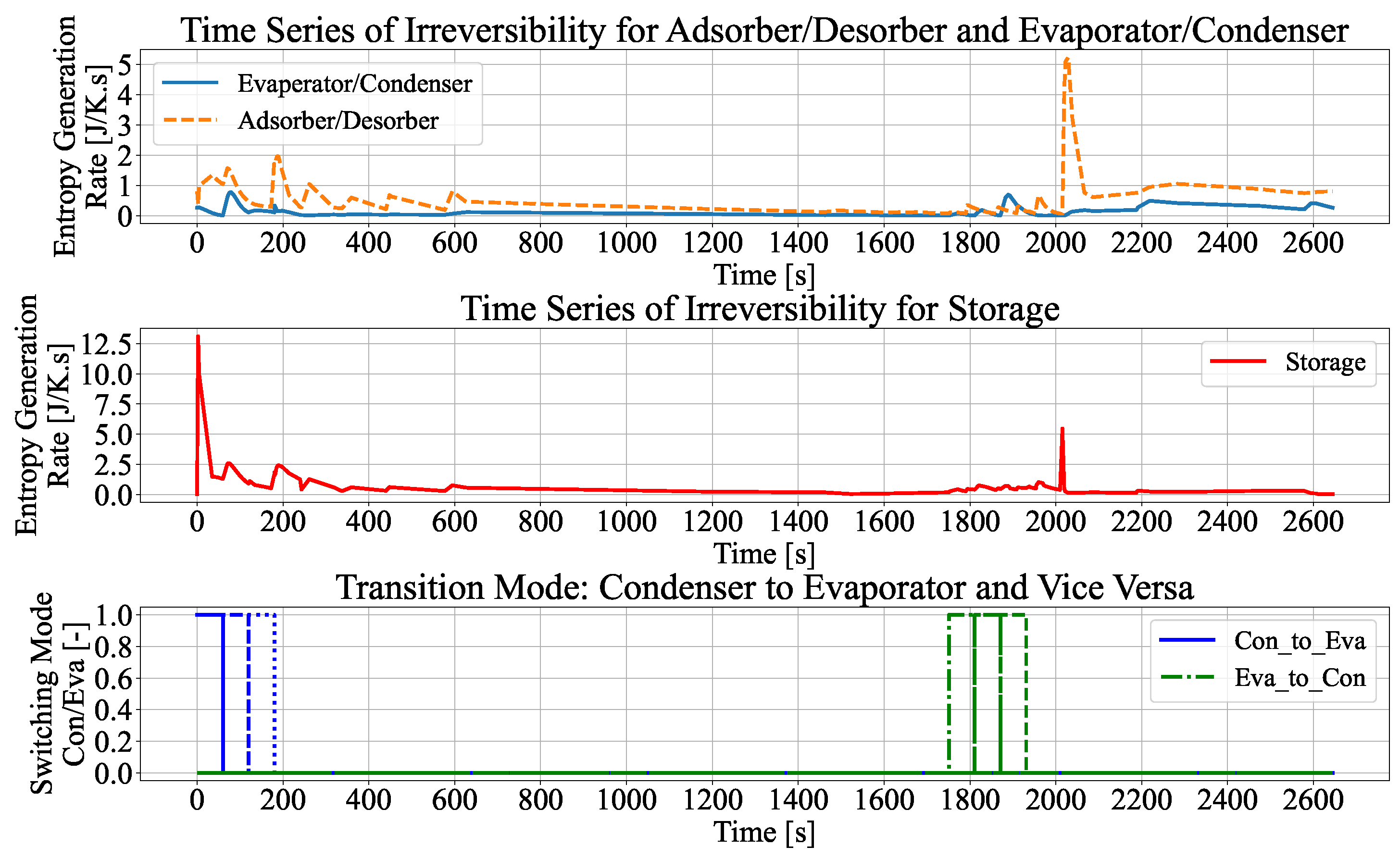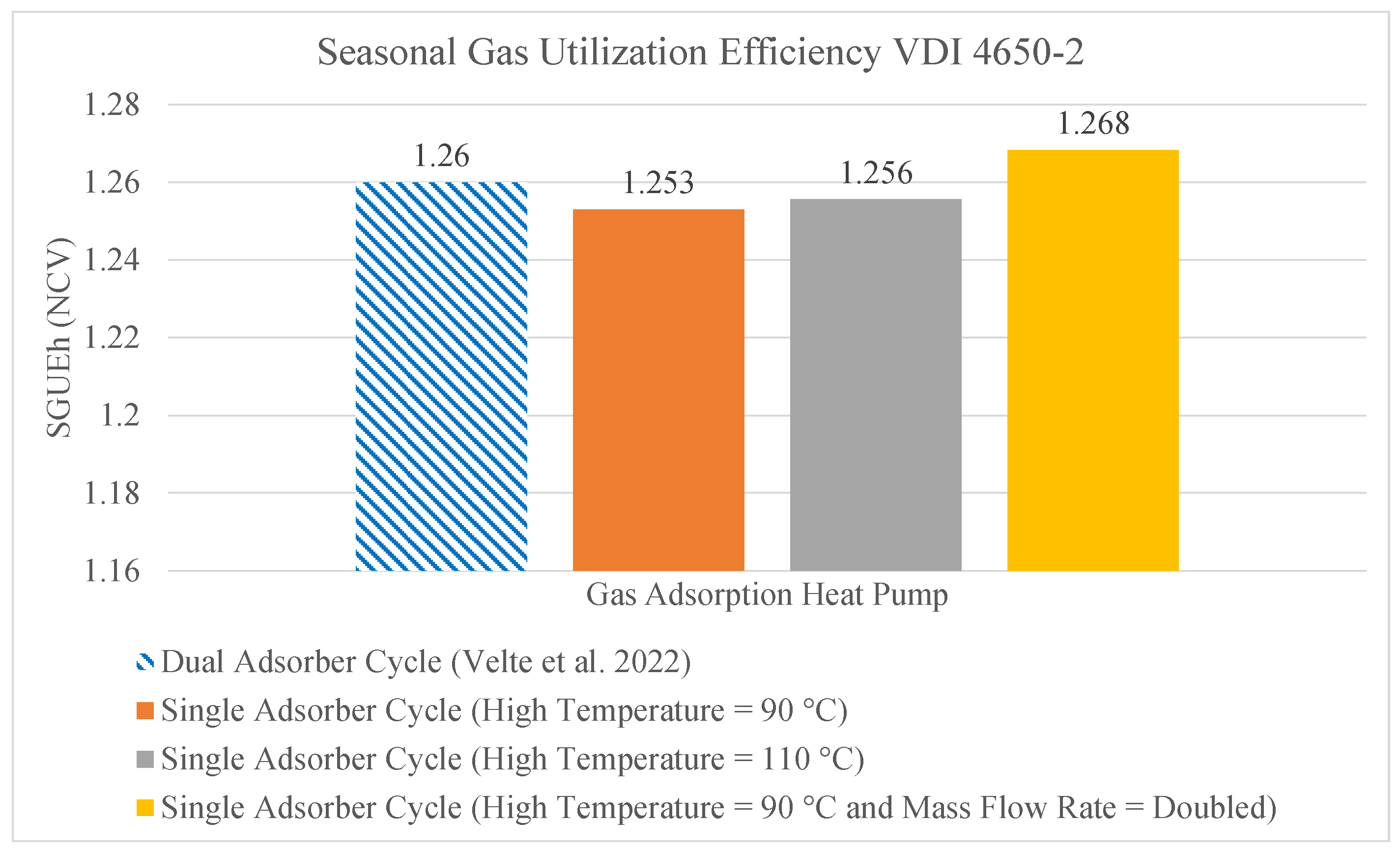3. Results
The idealized standard cycle of an adsorption heat pump consists of two isosteres and two isobars [
38]. However, in any real system, isosteric phases do not occur due to the heat capacity of the metal and the water inside of the evaporator and condenser [
38]. In real systems using the module type with a separate evaporator and condenser (right in
Figure 1), the switching phases between adsorption and desorption approximate isosteric behavior. Conversely, in systems with a single EC and no internal vapor valves, mass transfer within the module continuously occurs during the switching phases, leading to a larger deviation from isosteric behavior [
38].
In the following, we will discuss the simulation results of the single-adsorber cycle for the 30% load point according to VDI 4650-2 in some detail. The Clausius–Clapeyron diagram of that whole cycle is shown in
Figure 6, which shows the pre-cooling affected by the transition of the EC HX described above and the simultaneous cooling of the adsorber. Note that this pre-cooling is facilitated by the flexibility of connecting the single-adsorber cycle GAHP to the stratified storage, allowing the condenser temperature to drop from the heating supply temperature to the temperature of the storage bottom layer over a 180 s interval, as shown in the second plot of
Figure 7.
The pre-cooling process stores the available heat from the condenser in the storage. If this heat is not stored, some of the condensation heat during the next desorption process will be used to achieve the necessary sensible heating of the condenser to reach the space heating return temperature. However, by storing and using this heat, a greater amount of condensation heat remains within the useful temperature range, thereby improving the performance. During the pre-cooling, a 180 s transition phase occurs by extracting water from storage at a low mass flow rate to cool down the desorber, while the mass flow rate of the condenser remains unchanged. However, the condenser temperature levels changes, as shown in
Table 1. The results of the 180 s transition phase, as presented in
Table 5 and
Figure 6, show that the pre-cooling does not conclude at the end of this period. Then, the condenser connects to the borehole HX and cools down to the evaporator temperature by the end of the pre-cooling process. Furthermore, the pre-cooling process causes a portion of the previously condensed working fluid to evaporate and be adsorbed by the adsorbents, which reduces the condenser temperature.
The coefficient of performance and power density of GAHPs must be balanced as a trade-off [
15,
21,
25]. As a result, the adsorption process starts with a low adsorption rate, as indicated by the loading plot in
Figure 8. This low rate is due to the extraction water from a high-temperature layer (T1 in
Figure 8), which is a compromise for effective heat recovery. Then, inserting water from the lower-temperature layer of storage into the adsorber increases the driving temperature between the adsorber and stratified storage, subsequently enhancing the rate of adsorption. One observation from
Figure 6 is that there is a notable pressure drop during adsorption close to an adsorber temperature of 40 °C. This is related to the S-shaped water adsorption isotherm of SAPO-34 and occurs at the final adsorption step, when the drop in temperature of the fluid extracted from the storage strongly shifts the adsorption equilibria, leading to an increase in adsorption rate (at 600 s in
Figure 8). The pronounced variation in pressure during the ideally isobaric adsorption and desorption phases also indicates that the EC HX is undersized relative to the adsorber. However, this is not necessarily a design flaw, since, for the single-EC module type, there is always a trade-off between the total heat transfer and thermal mass of the EC HX [
39], making a relatively small evaporator HX a rational choice in some cases.
During the pre-heating phase, the evaporator temperature must reach the condenser temperature. Thus, the evaporator connects to the storage. A 180 s transition phase occurs by extracting water from storage at a low mass flow rate to heat up the adsorber, while the mass flow rate of the evaporator remains unchanged. However, the evaporator temperature level changes, as shown in
Table 1. The results of the 180 s transition phase, as presented in
Table 6 and
Figure 6, show that pre-heating does not conclude at the end of this period. The pre-heating process causes some of the working fluid within the adsorbents to desorb and flow to the evaporator, which increases the evaporator temperature to reach the space heating return temperature, explaining why the pre-heating process is not an isosteric process.
Figure 9 clearly shows that the heat recovery occurs during transition modes between the evaporator and condenser in a single-adsorber cycle, which is connected to the stratified storage tank. In the first transition mode, the condenser heat is delivered to the storage, resulting in the bottom-layer temperatures increasing. In contrast, during the second transition mode, cold water is delivered to the storage, resulting in a decrease in the bottom-layer temperatures.
Similar to the beginning of the adsorption process, during the desorption process,
Figure 6 shows that the desorber pressure is above the condenser’s saturation pressure, which continues until sufficient condensation occurs to reduce the pressure in the desorber. As the extraction index approaches the first layer with the highest temperature, the desorption process requires a higher water temperature to proceed effectively. Consequently, the burner is activated and connected to the desorber, as represented by the red plot in
Figure 8. This activation results in a noticeable increase in pressure, as demonstrated in
Figure 6. The connection between the desorber and the burner remains until the desorber outlet temperature reaches 90 °C. At this point, one cycle completes.
When the desorber outlet temperature reaches 90 °C, the burner turns off and connects to the stratified storage. As the burner’s metal is still hot, the temperature difference between the burner and the storage causes a spike in power due to high conduction heat transfer at the beginning of a cycle, as shown in the time series of the burner power in
Figure 8.
Following the module-level control strategy, if the temperature difference between the mean adsorbent temperature and the inlet water temperature is less than 2 °C, the extraction layer is altered. Consequently, the inlet temperature to the adsorber/desorber changes during an adsorber cycle as shown in
Figure 8. Moreover, the plot shows that the stratified storage layer temperatures increase during adsorption, while they decrease during desorption. It is also evident from
Figure 8 that the desorption phase is significantly shorter than the adsorption phase, which not only serves as an efficient parameter to maximize COP and power density [
40] but is also contrary to the behavior observed in the reference GAHP [
16].
The adsorber power time series within a cycle is depicted in
Figure 10. It shows that the first 180 s are associated with the transition mode from the desorption to adsorption process. Subsequently, the adsorption process takes place. After another 180 s, a transition mode from adsorption to the desorption process occurs, followed by the desorption process to complete a cycle of processes. In the second plot, the extraction and insertion of water from stratified storage into the adsorber/desorber are presented. Finally, the last plot illustrates the inlet and outlet heat transfer fluid temperature within the EC. The closely matched inlet and outlet water temperature at the end of each 180 s transition mode justifies the selection of a 180 s duration for transition phases.
Comparing the loading and power for representative operating points with a partial load of 30% in
Figure 8 and a partial load of 48% in
Figure 11 reveals two primary outcomes.
First, the maximum loading of the adsorption process reduces, which prevents the layers from attaining sufficient heating through the adsorption process to use in the desorption process.
Second, the burner activation period extends for high partial loads to heat the upper section of the storage and fulfill the heating demand in the consumption section. Therefore, at the partial load of 48%, the storage layer 1 temperature is set to the space heating supply temperature plus 8 to ensure that the space heating demands are met under this condition.
Since the stratified storage tank is designed to maintain conditions similar to the reference system [
15] for comparison with the single-adsorber cycle GAHP and is not sized for hot water preparation and heating buffer functions, these outcomes lead to suboptimal thermal stratification, with certain layers exhibiting negligible temperature variations, as shown in
Figure 12.
The entropy balance for main components of the single-adsorber cycle system is shown in
Figure 13. The highest spike in the adsorber/desorber is related to the direct burner mode. When the desorption process finishes, the burner turns off and connects to the storage. Therefore, the high temperature difference between the burner and storage leads to the high entropy generation at the beginning of the cycle, as shown in the second plot of
Figure 13. Additionally, the sources of relative irreversibility within the adsorber/desorber are detailed in
Figure 14. It reveals that the largest portion is related to “HTF-TW-AD”, which represents heat and mass transfer inside the pipe between the heat transfer fluid and tube wall in the adsorber/desorber. This finding aligns with Meunier’s results, which defined this phenomenon as external thermal coupling between isothermal heat reservoirs and temperature varying within the adsorber/desorber [
41]. The second-largest portion is “AD-EC”, denoting heat transfer between the adsorber/desorber and EC. The third-largest portion is “HTF-TW-EC”, representing heat and mass transfer inside the pipe between the heat transfer fluid and tube wall in the EC. Finally, the fourth-largest portion is “WP-TW-AD”, indicating heat transfer between the working pair and tube wall in the adsorber/desorber.
3.1. Gas Utilization Efficiency Compared to Reference System
The seasonal gas utilization efficiency (SGUE) of a heating system integrated with a single-adsorber cycle GAHP and stratified storage has been computed according to two distinct standards, DIN EN 12309-6 [
34] and VDI 4650-2 [
17], based on the net calorific value (NCV). The results are then compared with the SGUE of a heating system integrated with the dual-adsorber cycle GAHP and hydraulic separator (reference system) in
Figure 15. The variation in SGUE values for the same heating system, assessed under VDI 4650 2 [
17] and DIN EN 12309-6 [
34], can be attributed to the distinctive calculation methodologies employed in these two standards. VDI 4650 2 [
17] considers five points, excluding 100% from
Table 2, and computes the harmonic mean value based on these five points. Conversely, DIN EN 12309-6 incorporates six points and determines efficiency through a weighted average, including 100%. Consequently, VDI 4650 2 [
17] tends to predict SGUE optimistically, while DIN EN 12309-6 [
34] tends to predict it pessimistically. This divergence in prediction methods between the two standards is also documented in the reference system assessment for the dual-adsorber cycle GAHP [
16]. The observed differences arise from variations in the weighting or selection of different partial load points. Specifically, the weather data utilized for the Potsdam site result in a greater number of operating hours at lower part-load points in VDI 4650 2 [
17] compared to what is assumed in DIN EN 12309-6 [
34].
Sensitivity Analysis: Desorption Temperature and Flow Rate
The sensitivity analysis of the single-adsorber cycle GAHP consists of two parts. Firstly, the alteration of the high-temperature source from 90 °C to 110 °C, and secondly, doubling the mass flow rate of the burner and adsorber while keeping the high-temperature source at 90 °C.
Figure 16 provides the results of the gas utilization efficiency for each part-load ratio mentioned in
Table 2 for VDI 4650-2 [
17].
3.2. Seasonal Gas Utilization Efficiency
Figure 17 illustrates the SGUE in a heating system integrated with a single-adsorber cycle GAHP and stratified storage under three different sensitivity analyses, comparing it with the reference system including a dual-adsorber cycle [
16]. The results indicate that doubling the mass flow rate in the burner and adsorber leads to a higher SGUE than the validated model. This improvement is primarily attributed to the increase in gas utilization efficiency by 11.3% for the 13% part-load ratio and 7.3% for the 48% part-load ratio, while decreasing by 3% for the 39% part-load ratio in
Figure 16. This shows that there is still room for optimizing mass flow controls and fully utilizing this degree of freedom in storage-integrated single-adsorber cycles.
3.3. Remarks on Scalability and Adaptability of System
The degrees of freedom of the storage-coupled single-adsorber cycle with regard to adsorber and EC mass flows as well as storage layer switching rules should make it highly adaptable to different operating conditions and/or adsorber properties or even working pairs. However, there is not yet a systematic understanding of how to design the system controls to make the best use of these degrees of freedom. Tuning the controls for this system involved some trial and error, and we would very much welcome further work of control experts on this system. Regarding the chosen heating supply design temperature of 55 °C, it should be relevant to a significant fraction of buildings in many countries where similar types of radiators are employed and similar building insulation standards are applied as in Germany. The VDI 4650-2 and DIN EN 12309-6 rules provide a suitable framework for a relatively simple prediction of seasonal gas utilization efficiencies, although deviations from the results of full annual simulations can be significant [
16].
Scaling to different powers for larger or smaller buildings should be relatively straightforward. When the storage size is scaled with the nominal heating power, storage size might become the limiting factor for finding installation space at higher heating powers.
